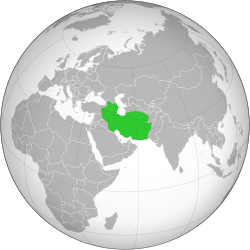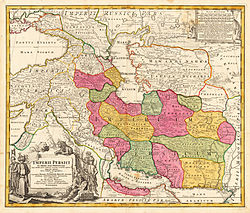
Back Safawidiese Ryk Afrikaans Imperio Safavida AN الدولة الصفوية Arabic الدوله الصفويه ARZ Səfəvilər Azerbaijani صفوی ایمپیراتورلوغو AZB Сәфәүиҙәр дәүләте Bashkir সাফাভীয় সাম্রাজ্য Bengali/Bangla Сефевиин улас BXR Imperi Safàvida Catalan
Negara Agung Iran Raya ملک وسیعالفضای ایران Negara Iran مملکت ایران | |||||||||||||||||||||||||||||
|---|---|---|---|---|---|---|---|---|---|---|---|---|---|---|---|---|---|---|---|---|---|---|---|---|---|---|---|---|---|
| 1501–1736 | |||||||||||||||||||||||||||||
 Kekaisaran Safawi di bawah pimpinan Shah Abbas | |||||||||||||||||||||||||||||
 | |||||||||||||||||||||||||||||
| Status | Kekaisaran | ||||||||||||||||||||||||||||
| Ibu kota | |||||||||||||||||||||||||||||
| Bahasa yang umum digunakan | |||||||||||||||||||||||||||||
| Agama | Syiah Dua Belas Imam (resmi) | ||||||||||||||||||||||||||||
| Pemerintahan | Monarki | ||||||||||||||||||||||||||||
| Shah | |||||||||||||||||||||||||||||
• 1501–1524 | Ismail I (pertama) | ||||||||||||||||||||||||||||
• 1732–1736 | Abbas III (terkahir) | ||||||||||||||||||||||||||||
| Wazir Agung | |||||||||||||||||||||||||||||
• 1501–1507 | Amir Zakariya (pertama) | ||||||||||||||||||||||||||||
• 1729–1736 | Nader Qoli Beg (terakhir) | ||||||||||||||||||||||||||||
| Legislatif | Dewan Negara | ||||||||||||||||||||||||||||
| Era Sejarah | Early modern period | ||||||||||||||||||||||||||||
• Pembentukan tarekat Safawi oleh Safi ad-din Ardabili | 1301 | ||||||||||||||||||||||||||||
• Didirikan | 22 Desember[5] 1501 | ||||||||||||||||||||||||||||
• Invasi Hotak | 1722 | ||||||||||||||||||||||||||||
• Penaklukan kembali oleh Nader Shah | 1726–1729 | ||||||||||||||||||||||||||||
• Dibubarkan | 8 Maret 1736 | ||||||||||||||||||||||||||||
• Penobatan Nader Shah | 8 Maret 1736 [6] | ||||||||||||||||||||||||||||
| Luas | |||||||||||||||||||||||||||||
| 1630[7] | 2.900.000 km2 (1.100.000 sq mi) | ||||||||||||||||||||||||||||
| Mata uang | Tuman, Abbasi, Shahi.[8]
| ||||||||||||||||||||||||||||
| |||||||||||||||||||||||||||||
a Agama negara.[9]
b Bahasa resmi,[10] mata uang,[11][12] administrasi sipil,[13] pengadilan (sejak Isfahan menjadi ibu kota),[14] sastra,[11][13][15] wacana teologis,[11] diplomatik korespondensi, sejarah,[16] pos keagamaan berbasis pengadilan[17] c Pengadilan,[18][19][20] pemuka agama, militer,[16][21][22][23] bahasa ibu,[16] puisi[16] d Pengadilan[24] | |||||||||||||||||||||||||||||
Iran Safawi atau Persia Safawi, juga disebut sebagai Kekaisaran Safawi, adalah salah satu kerajaan Iran terbesar setelah penaklukan Persia oleh Muslim abad ke-7, yang diperintah dari tahun 1501 hingga 1736 oleh dinasti Safawiyah. Hal ini sering dianggap sebagai awal dari sejarah Iran modern, serta salah satu kerajaan mesiu. Shah Safawi Ismail I menetapkan denominasi agama Syiah Dua Belas Imam sebagai agama resmi kekaisaran, menandai salah satu titik balik terpenting dalam sejarah Islam.[25]
Dinasti Safawi berasal dari tarekat Sufisme Safawi, yang didirikan di kota Ardabil di wilayah Azerbaijan. Dinasti Safawi adalah dinasti Iran yang berasal dari bangsa Kurdi tetapi selama pemerintahan mereka mereka menikah dengan orang-orang Turkmen, Georgia, Adighe, dan Yunani Pontos, namun mereka berbahasa Turki dan Turkifikasi. Dari basis mereka di Ardabil, Safawi membangun kendali atas bagian-bagian Iran Raya dan menegaskan kembali identitas Iran di wilayah itu, sehingga menjadi dinasti asli pertama sejak dinasti Buwaihi yang mendirikan negara nasional yang secara resmi dikenal sebagai Iran.[26]
Safawi memerintah 1501-1722 (mengalami pemulihan singkat 1729-1736 dan 1750-1773) dan, pada puncaknya, mereka menguasai semua apa yang sekarang Iran, Azerbaijan, Bahrain, Armenia, Georgia timur, bagian dari Kaukasus Utara termasuk Rusia, Irak, Kuwait, dan Afghanistan, serta bagian dari Turki, Suriah, Pakistan, Turkmenistan, dan Uzbekistan.[27]
Meskipun Iran Safawi runtuh pada tahun 1736, warisan yang mereka tinggalkan adalah kebangkitan Iran sebagai benteng ekonomi antara Timur dan Barat, pembentukan negara dan birokrasi yang efisien berdasarkan "checks and balances", inovasi arsitektur safawi, dan patronasi untuk seni. Safawi juga telah meninggalkan jejak mereka hingga era sekarang dengan menetapkan Syiah Dua Belas Imam sebagai agama negara Iran, serta menyebarkan Islam Syiah di sebagian besar Timur Tengah, Asia Tengah, Kaukasus, Anatolia, Teluk Persia, dan Mesopotamia,[28] Adighe,[29][30] dan Yunani Pontos.[31]
Kesalahan pengutipan: Ditemukan tag <ref> untuk kelompok bernama "lower-alpha", tapi tidak ditemukan tag <references group="lower-alpha"/> yang berkaitan
- ^ Matthee, Rudi (1 September 2009). "Was Safavid Iran an Empire?". Journal of the Economic and Social History of the Orient. 53 (1): 241. doi:10.1163/002249910X12573963244449.
The term 'Iran', which after an absence of some six centuries had re-entered usage with the Ilkhanid branch of the Mongols, conveyed a shared self-awareness among the political and cultural elite of a geographical entity with distinct territorial and political implications. A core element of the Safavid achievement was the notion that the dynasty had united the eastern and western halves of Iran, Khurasan and Herat, the lands of the Timurids, in the East, and the territory of the Aq-Quyunlu in the West. The term mulk-i vasi' al-faza-yi Iran, 'the expansive realm of Iran', found in the seventeenth-century chronicle, Khuld-i barin, and again, in near identical terms, in the travelogue of Muhammad Rabi Shah Sulayman's envoy to Siam in the 1680s, similarly conveys the authors pride and self-consciousness with regard to the territory they inhabited or hailed from.
- ^ Roger Savory (2 January 2007). "The Safavid state and polity". Iranian Studies. 7 (1–2): 206. doi:10.1080/00210867408701463.
The somewhat vague phrase used during the early Safavid period, mamalik-i mahrusa, had assumed more concrete forms: mamālik-i īrān; mamālik-i 'ajam; mamlikat-i īrān; mulk-i īrān; or simply īrān. The royal throne was variously described as sarīr-i saltanat-i īrān; takht-i īrān; and takht-i sultān (sic)-i īrān. The inhabitants of the Safavid empire are referred to as ahl-i īrān, and Iskandar Beg describes himself as writing the history of the Iranians (sharh-i ahvāl-i īrān va īrāniān). Shah Abbas I is described as farmānravā-yi īrān and shahryār-i īrān; his seat is pāyitakht-i pādishāhān-i īrān, takhtgāh-i salātin-i īrān, or dār al-mulk-i īrān. His sovereign power is referred to as farmāndahi-yi mulk-i īrān, saltanat va pādishāhi-yi īrān, pādishāhi-yi īrān. The cities of Iran (bilād-i īrān) are thought of as belonging to a positive entity or state: Herat is referred to as a'zam-i bilād-i īrān (the greatest of the cities of Iran) and Isfahan as khulāsa-yi mulk-i īrān (the choicest part of the realm of Iran). ... The sense of geographical continuity referred to earlier is preserved by a phrase like kull-i vilāyat-i īrānzamīn. ... Affairs of state are referred to as muhimmāt-i īrān. To my mind however, one of the clearest indications that the Safavid state had become a state in the full sense of the word is provided by the revival of the ancient title of sipahsālār-i īrān or "commander-in-chief of the armed forces of Iran".
- ^ Flaskerud, Ingvild (2010). Visualizing Belief and Piety in Iranian Shiism. A&C Black. hlm. 182–3. ISBN 978-1-4411-4907-7.
- ^ "... the Order of the Lion and the Sun, a device which, since the 17 century at least, appeared on the national flag of the Safavids the lion representing 'Ali and the sun the glory of the Shiʻi faith", Mikhail Borisovich Piotrovskiĭ, J. M. Rogers, Hermitage Rooms at Somerset House, Courtauld Institute of Art, Heaven on earth: Art from Islamic Lands: Works from the State Hermitage Museum and the Khalili Collection, Prestel, 2004, p. 178.
- ^ Ghereghlou, Kioumars (October–December 2017). "Chronicling a Dynasty on the Make: New Light on the Early Ṣafavids in Ḥayātī Tabrīzī's Tārīkh (961/1554)". Journal of the American Oriental Society. 137 (4): 827. doi:10.7817/jameroriesoci.137.4.0805 – via Columbia Academic Commons.
Shah Ismāʿīl's enthronement took place in Tabrīz immediately after the battle of Sharūr, on 1 Jumādā II 907/22 December 1501.
- ^ Elton L. Daniel, The History of Iran (Greenwood Press, 2001) p. 95
- ^ Bang, Peter Fibiger; Bayly, C. A.; Scheidel, Walter (2020-12-02). The Oxford World History of Empire: Volume One: The Imperial Experience (dalam bahasa Inggris). Oxford University Press. hlm. 92–94. ISBN 978-0-19-977311-4.
- ^ Ferrier, RW, A Journey to Persia: Jean Chardin's Portrait of a Seventeenth-century Empire, p. ix.
- ^ The New Encyclopedia of Islam, Ed. Cyril Glassé, (Rowman & Littlefield Publishers, 2008), 449.
- ^ Kesalahan pengutipan: Tag
<ref>tidak sah; tidak ditemukan teks untuk ref bernamaRoemer 189 - ^ a b c Rudi Matthee, "Safavids" in Encyclopædia Iranica, accessed on April 4, 2010. "The Persian focus is also reflected in the fact that theological works also began to be composed in the Persian language and in that Persian verses replaced Arabic on the coins." "The political system that emerged under them had overlapping political and religious boundaries and a core language, Persian, which served as the literary tongue, and even began to replace Arabic as the vehicle for theological discourse".
- ^ Ronald W Ferrier, The Arts of Persia. Yale University Press. 1989, p. 9.
- ^ a b John R Perry, "Turkic-Iranian contacts", Encyclopædia Iranica, January 24, 2006: "... written Persian, the language of high literature and civil administration, remained virtually unaffected in status and content"
- ^ Kesalahan pengutipan: Tag
<ref>tidak sah; tidak ditemukan teks untuk ref bernamaCyril Glassé 2003, pg 392 - ^ Arnold J. Toynbee, A Study of History, V, pp. 514–515. Excerpt: "in the heyday of the Mughal, Safawi, and Ottoman regimes New Persian was being patronized as the language of literae humaniores by the ruling element over the whole of this huge realm, while it was also being employed as the official language of administration in those two-thirds of its realm that lay within the Safawi and the Mughal frontiers"
- ^ a b c d Kesalahan pengutipan: Tag
<ref>tidak sah; tidak ditemukan teks untuk ref bernamamazzaoui - ^ Ruda Jurdi Abisaab. "Iran and Pre-Independence Lebanon" in Houchang Esfandiar Chehabi, Distant Relations: Iran and Lebanon in the Last 500 Years, IB Tauris 2006, p. 76: "Although the Arabic language was still the medium for religious scholastic expression, it was precisely under the Safavids that hadith complications and doctrinal works of all sorts were being translated to Persian. The ʻAmili (Lebanese scholars of Shiʻi faith) operating through the Court-based religious posts, were forced to master the Persian language; their students translated their instructions into Persian. Persianization went hand in hand with the popularization of 'mainstream' Shiʻi belief."
- ^ Floor, Willem; Javadi, Hasan (2013). "The Role of Azerbaijani Turkish in Safavid Iran". Iranian Studies. 46 (4): 569–581. doi:10.1080/00210862.2013.784516.
- ^ Hovannisian, Richard G.; Sabagh, Georges (1998). The Persian Presence in the Islamic World. Cambridge: Cambridge University Press. hlm. 240. ISBN 978-0521591850.
- ^ Axworthy, Michael (2010). The Sword of Persia: Nader Shah, from Tribal Warrior to Conquering Tyrant. I.B.Tauris. hlm. 33. ISBN 978-0857721938.
- ^ Roger Savory (2007). Iran Under the Safavids. Cambridge University Press. hlm. 213. ISBN 978-0-521-04251-2.
qizilbash normally spoke Azari brand of Turkish at court, as did the Safavid shahs themselves; lack of familiarity with the Persian language may have contributed to the decline from the pure classical standards of former times
- ^ Kesalahan pengutipan: Tag
<ref>tidak sah; tidak ditemukan teks untuk ref bernamacambridgesafa - ^ Price, Massoume (2005). Iran's Diverse Peoples: A Reference Sourcebook. ABC-CLIO. hlm. 66. ISBN 978-1-57607-993-5.
The Shah was a native Turkic speaker and wrote poetry in the Azerbaijani language.
- ^ Blow 2009, hlm. 165–166 "Georgian, Circassian and Armenian were also spoken [at the court], since these were the mother-tongues of many of the ghulams, as well as of a high proportion of the women of the harem. Figueroa heard Abbas speak Georgian, which he had no doubt acquired from his Georgian ghulams and concubines."
- ^ Savory, Roger (2012) [1995]. "Ṣafawids". Dalam Bosworth, C. E.; van Donzel, E. J.; Heinrichs, W. P.; Lewis, B.; Pellat, Ch.; Schacht, J. Encyclopaedia of Islam, Second Edition. 8. Leiden and Boston: Brill Publishers. doi:10.1163/1573-3912_islam_COM_0964. ISBN 978-90-04-16121-4.
- ^ Herzig, Edmund; Stewart, Sarah (2011). Early Islamic Iran. I. B. Tauris.
- ^ Iran Safawi dalam Encyclopædia Iranica, "The origins of the Safavids are clouded in obscurity. They may have been of Kurdish origin (see R. Savory, Iran Under the Safavids, 1980, p. 2; R. Matthee, "Safavid Dynasty" at iranica.com), but for all practical purposes they were Turkish-speaking and Turkified."
- ^ Aptin Khanbaghi (2006) The Fire, the Star and the Cross: Minority Religions in Medieval and Early. London & New York. IB Tauris. ISBN 1-84511-056-0, pp. 130–1
- ^ Yarshater 2001, hlm. 493.
- ^ Khanbaghi 2006, hlm. 130.
- ^ Anthony Bryer. "Greeks and Türkmens: The Pontic Exception", Dumbarton Oaks Papers, Vol. 29 (1975), Appendix II "Genealogy of the Muslim Marriages of the Princesses of Trebizond"



